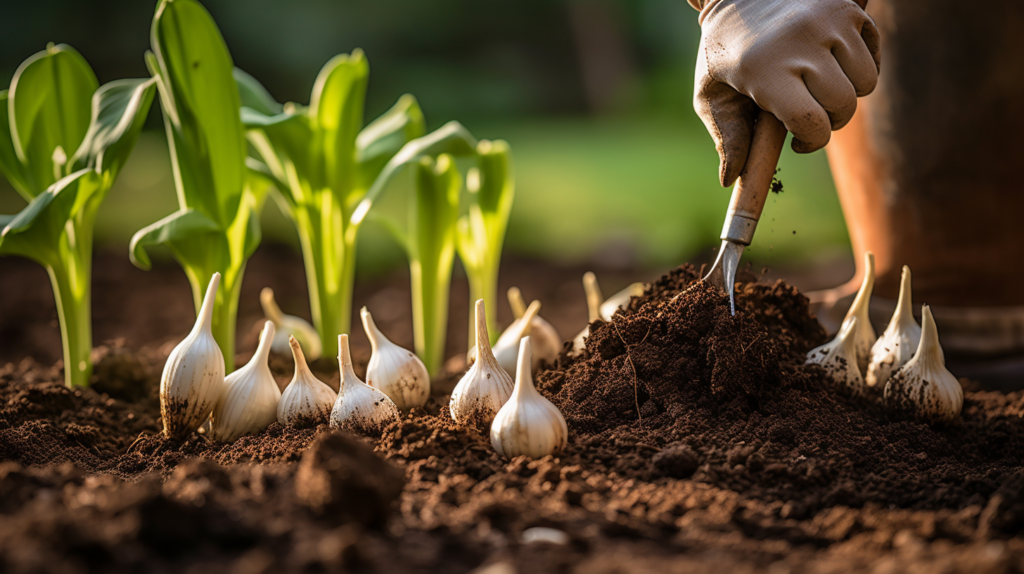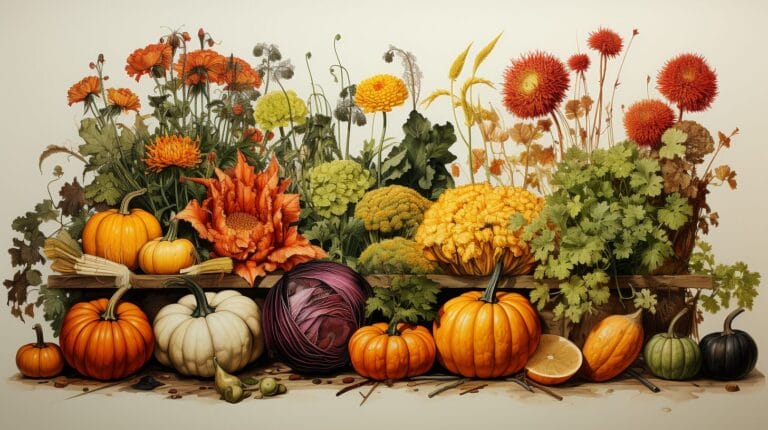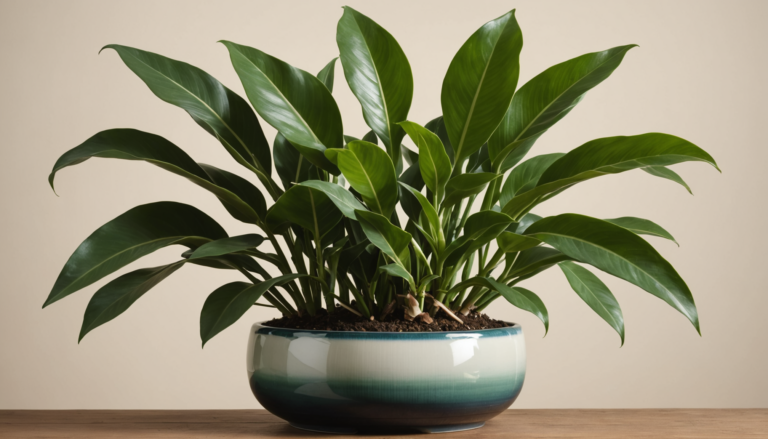In today’s discussion, we are addressing the thought, “Is it possible to plant garlic from the grocery store?”. After diving deep into the soil (yes, that’s a pun), I’m thrilled to present my discoveries. If you’re as intrigued by the idea of trying this as I am, stay tuned.
We’ll explore the best techniques, potential hurdles, and the joy of harvesting garlic.
Let’s get our hands dirty!
Key Takeaways
- Organic garlic bulbs tend to sprout better and are healthier for planting.
- Supermarket garlic is often treated to prevent sprouting, hindering its growth when planted.
- Seed garlic is cultivated explicitly for planting and ensures disease-free and viable growth.
- Garlic bought from grocery stores may carry diseases like white rot and can be affected by pests such as nematodes and thrips.
Can You Plant Grocery Store Garlic? Choosing the Right Garlic Bulb

Choosing the correct garlic bulb from your local grocery store is crucial for successful growth. I’ve found that they tend to sprout better, and selecting healthy ones is vital.
It’s also essential to understand the differences between common commercial garlic and garlic seed.
Look for organic garlic bulbs for better success
The potential for success is higher when I opt for organic ones from the grocery store. Organic garlic is usually healthier, more robust, and not treated with growth inhibitors that can sometimes be found in non-organic grocery store bulbs. This makes these organic bulbs more likely to sprout and grow successfully when you plant commercial garlic.
It’s crucial to select firm, plump bulbs with unbroken skin. Discoloration or soft spots could signify disease or damage, potentially lowering your success rate.
Identify healthy bulbs suitable for planting
So, let’s dive right in and identify those healthy bulbs suitable for planting, but remember, only some bulbs that look good on the outside are perfect for your garden. When you’re looking to plant store-bought garlic, it’s crucial to be selective.
- Firstly, inspect the garlic heads. It should be plump, firm, and free of mold or blemishes. If it’s soft or shriveled, it’s likely past its prime.
- Secondly, the larger the garlic heads, the better. Big bulbs often produce big cloves, which we want in our garden.
- Lastly, remember to check for sprouts. A sprouting store-bought garlic is a happy camper eager to grow.
Differences between common supermarket garlic vs. seed garlic
Why, then, would you need to consider the differences between common commercial garlic and seed garlic, and how does this impact your choice of garlic heads for planting?
Well, if you’re planning to grow garlic from the grocery, it’s essential to know these differences. Commercial garlic is generally cheaper and readily available. Still, it’s often treated to prevent sprouting, hindering plant growth.
Garlic seed, on the other hand, is specifically cultivated for planting, ensuring it’s disease-free and viable for growth.
While growing purchased garlic can be a fun experiment, if you’re serious about a robust garlic harvest, consider investing in garlic seed instead of supermarket-bought garlic cloves.
Remember that when you plant garlic, there are different types of garlic to grow, such as softneck and hardneck garlic. Each variety of garlic has its characteristics and flavor profiles. Additionally, consider the climate you are in, as garlic can be a great addition to your garden, especially in a cold climate.
Ready to take planting your garlic to the next level? Try growing your garlic hydroponically.
Planting Store-Bought Garlic: Tips and Techniques

Now that we’ve chosen the appropriate garlic bulb, let’s discuss how to plant it.
We’ll start by determining the right time to plant garlic in your vegetable garden.
I’ll also guide you on how to prepare and separate garlic bulbs into cloves and the best method to plant them.
The right time to plant garlic in your vegetable garden
Where should I start when determining the best time to plant my supermarket-bought garlic in the vegetable garden? The timing largely depends on your local climate and the garlic variety. Generally, the best time to plant garlic is in the fall, particularly for hardneck varieties that require a period of cold to develop bulbs.
Here’s a simple guide to help you master the process:
- Fall Planting: Plant garlic in the fall, about six weeks before the ground freezes. This allows the roots to develop before winter.
- Garlic Varieties: Choose garlic from the grocery store suited to your local climate.
- Prepare the Garden: Ensure your vegetable garden is well-prepared with rich, well-draining soil.
With these tips, you can successfully grow store-bought garlic in your garden.
With these tips, you can successfully grow supermarket-bought garlic in your garden. Garlic cloves from the grocery are an excellent choice for this purpose, and they can be planted in the fall for a successful harvest in the following year.
How to prepare and separate garlic bulbs into cloves
Before I get my hands dirty, let’s talk about the garlic bulb’s structure and how to separate it into individual cloves for planting correctly.
When you pick up a whole garlic from the supermarket, you’ll notice a cluster of cloves held together by a papery husk. To prepare, gently peel away this outer layer, revealing the individual cloves. Be careful not to damage them – we aim for unblemished cloves from the grocery store to ensure healthy growth.
Now, it’s time to separate. Just break apart the bulb, freeing each clove. Remember, the larger the clove, the bigger the resulting garlic bulb.
Once separated, you’re ready to plant each clove.
That’s how to prepare and separate garlic bulbs into cloves.
Discuss the suitable planting method for garlic
I’ve got five key steps to follow when planting your store-bought garlic, and each one is crucial to the success of your future garlic harvest.
Let’s dive right into discussing the suitable planting method for garlic:
- First, select a garlic clove from the supermarket that’s large and healthy. Larger cloves will yield more significant.
- Next, prepare your soil. Garlics are well-draining soil, rich in organic matter. Early spring is the ideal time for planting.
- Finally, plant garlic in your garden about 2 inches deep with the pointed end facing up. It may take for garlic to grow, so be patient.
These tips and techniques will yield a robust garlic harvest from simple supermarket cloves. Remember, patience is critical – garlic is better when it’s allowed to develop properly. Garlic is a low-maintenance crop, and it’s worth the wait.
Provide Proper Care to Your Growing Garlic
Next, let’s talk about how to care for your growing garlic.
It’s crucial to understand the watering needs of your garlic plant and ensure it gets sufficient sun exposure.
We’ll discuss the nutrients and soil mix that encourage healthy garlic growth.
Understand the watering needs of your garlic plant
I’m keenly aware of the importance of properly watering my plant, considering its unique needs. It’s not a guessing game if you’re committed to growing your garlic successfully.
Here’s a simple breakdown of its watering needs:
- Initially, when garlic is grown, it requires consistent watering. This ensures that the roots establish themselves well.
- Once the plant is established, reduce the watering. The soil should be slightly moist but not soggy. Overwatering can lead to rot and other diseases.
- Just before harvest, stop watering. This allows it to dry and harden for storage.
Ensuring sufficient sun exposure
In addition to watering, I must ensure that my garlic is in total sun exposure for most of the day. This is especially true when planting garlic from store-bought – garlic needs at least six hours of direct sunlight daily to grow best. Garlic grows best in full sun, as it helps to dry the soil, preventing too much moisture, which can lead to rot.
Therefore, ensuring sufficient sun exposure is vital for successful garlic cultivation. By positioning my plant in a sunny spot in my garden, it dramatically enhances growth and yields a more bountiful harvest. Remember, a well-situated, sun-kissed plant can thrive and provide a satisfying reward for your efforts.
You can also use elephant garlic cloves and plant them to grow your garlic. When garlic is used to grow garlic greens, it’s also essential to cover the garlic bed to protect the plants from excessive moisture.
Remember, garlic is much more versatile than you might think, and it’s not just a seasoning – it’s also a fantastic crop to cultivate in your garden.
Essential nutrients and soil mix for encouraging garlic growth
I’ve discovered that three essential nutrients – nitrogen, phosphorus, and potassium – are vital for encouraging robust garlic growth. To successfully grow garlic, especially garlic in containers, it’s crucial to have a well-draining garden soil rich in these elements.
Here are three easy steps to provide proper care to your growing garlic:
- Regularly fertilize your soil with a balanced mix of nitrogen, phosphorus, and potassium.
- Aim for a pH between 6.0 and 7.0 to ensure your garlic benefits from these nutrients.
- Water consistently, but avoid water-logging your soil, which can lead to rot.
These efforts won’t only help you plant and grow healthy garlic but will also maximize the yield of your garlic harvest.
Identify and Overcome Common Growing Hurdles
Now, let’s discuss some common challenges you might face while growing garlic.
Recognizing diseases and pests, understanding the survival odds of store-bought versus garlic seed, and handling bolting are hurdles you’ll have to overcome.
Don’t worry. I’m here to help you navigate these obstacles.
Recognize common diseases and pests affecting garlic
I’ve identified five common diseases and pests that can pose significant hurdles when growing garlic, especially if you’re using cloves from the grocery store. Recognizing these common diseases and pests affecting garlic is always the first step to overcoming these obstacles.
- White Rot: This fungus affects the roots and leaves, causing yellowing and wilting. Unfortunately, garlic sold at stores often carries this disease.
- Nematodes: These microscopic worms attack the garlic’s roots, stunting growth. Garlic can’t thrive when infested with nematodes.
- Thrips: These tiny insects feed on garlic leaves, causing them to turn silver or white.
When trying to grow garlic, these are your significant foes. But don’t be disheartened. With proper care and vigilance, you can successfully grow purchased garlic for spring planting.
Store-bought vs. seed garlic: Understanding survival odds
Often, I’m asked whether it’s better to plant purchased garlic or invest in garlic seed, given the common hurdles associated with each. Here’s the lowdown: buying garlic from a grocery store can be a gamble. It’s typically treated to prevent sprouting, which can hinder growth when you plant garlic.
Seed garlic, obtained from a seed store or nursery, is a safer bet. It’s bred explicitly for planting, offering higher survival odds. However, it’s more expensive and less readily available than purchased garlic.
Recognize if your garlic is bolting and how to handle it
Regularly, I encounter bolting in my garlic plants. Still, it’s relatively easy to manage once you know what to look for. To recognize if your garlic is bolting, you need to observe its growth habits.
Here’s my three-step process:
- Keep an eye out for a long, curly stalk growing from the center of your plant. This is the garlic scape, the first sign your garlic is bolting.
- Older garlic plants are more likely to bolt. If your plant’s leaves are mature and the plant is tall, it’s probably bolting.
- To handle it, cut off the scape at its base. This will direct the plant’s energy back into the head, increasing its size and potency.
Can I Use Grocery Store Garlic to Grow My Own Garlic Plants?
Using grocery store garlic to grow your own garlic plants is definitely possible, without the risk of killing mint in your garden. Simply choose organic garlic, as it hasn’t been treated with chemicals that inhibit growth. Plant the cloves in well-drained soil, making sure to keep them watered but not overly wet. With patience and proper care, you’ll have your own fresh garlic in no time!
Can I Plant Grocery Store Garlic to Grow Small Purple Perennial Flowers?
Yes, planting grocery store garlic can lead to the growth of hardy purple perennial flowers. With careful cultivation, garlic cloves can produce vibrant blooms that adorn your garden year after year. Embrace the opportunity to transform a kitchen staple into a captivating floral display that will surely charm any garden enthusiast.
Harvesting and Using Your Home-Grown Garlic
Now that we’ve tackled how to plant and grow your garlic let’s move on to the exciting part: harvesting and using your home-grown produce.
I’ll guide you in recognizing when your garlic is ready for the taking and the proper way to harvest and cure it.
Of course, I’ll also share some delicious ways to use fresh, home-grown garlic in your meals.
How to tell when your garlic is ready to harvest
While I’ve found that patience is critical when growing garlic, it’s also essential to know when your crop is ready to be harvested.
Here are a few telltale signs that your garlic is ready to leave its cozy garlic bed:
- The lower leaves brown: Once, the lower garlic leaves turn brown, but five or six green leaves remain, your garlic is ready for harvest.
- No sprouting: If your garlic is sprouting already, it’s gone past its prime. It’s still edible, but not ideal.
- The size: A good size indicates ripe garlic.
Harvest garlic gently to prevent bruising. Dry it in an excellent, ventilated space. Enjoy the fruits of your labor in your favorite recipes, or store them for later use.
If you want to buy seed garlic, choose a mild garlic variety for planting, as garlic is one of the most popular crops for home gardeners.
The right way to harvest and cure garlic
I’ve got a knack for harvesting and curing garlic, and I’m excited to share the right way to get the most out of your home-grown cloves.
Once your homegrown garlic is ripe and ready, pull it up gently, taking care not to bruise it.
Now comes the curing process. Hang them in a well-ventilated, shady spot for about two weeks. This process allows the garlic stores to develop and the flavors to intensify, enhancing the taste of your fresh garlic.
Finally, store them in a cool, dark place. This helps to maintain their freshness and flavor, ensuring you get the most out of your harvest.
With these steps, you’ll master the right way to harvest and cure garlic quickly!
Delicious uses for your store-bought, home-grown garlic
After you’ve harvested and cured your garlic, there’s a multitude of delicious recipes you can create with it, which can elevate the taste of your dishes. When you buy organic garlic to plant, you’re on your way to a fulfilling kitchen and planting experience.
Here are three delicious uses for your store-bought, home-grown garlic:
- Garlic Butter: It’s simple and versatile. Use it on bread or melt it over steak.
- Roasted Garlic: Regularly roasting garlic brings out its sweet, mellow flavor.
- Garlic Infused Oil: It’s perfect for salads, bread dips, and cooking.
The joy of using your garlic is unparalleled. Once you start, you’ll be hooked on the home-grown taste.
Conclusion
So, can you plant grocery-store garlic? Absolutely! With the correct bulb, proper planting, and diligent care, you’ll see success.
You might encounter a few challenges, but don’t let that deter you. When it’s time to harvest, the satisfaction of using your home-grown garlic makes it all worthwhile.
Give it a go – you might be surprised at how green your thumb can be!
Frequently Asked Questions
What Are the Potential Risks or Downsides of Planting Grocery Store Garlic?
I’ve found that the principal risks of planting it include potential disease transmission, poor growth due to unsuitability to local conditions, and the chance of it being treated to prevent sprouting.
Can You Grow Garlic Indoors From a Grocery Store Bulb?
I can undoubtedly grow garlic indoors from a grocery store bulb. It’s easy to do. Just ensure it gets plenty of light, water, and proper soil. The results can be rewarding.
Are There Any Specific Grocery Stores Known for Selling Garlic That Grows Well?
I need to find out about specific grocery stores selling garlic that are known for growing well. It’s more about the garlic’s quality and type than where it’s purchased. Organic garlic may offer better growth potential.
How Much Time Does It Typically Take for Grocery Store Garlic to Fully Grow?
It typically takes about nine months to mature, starting from planting thoroughly. But remember, the quality of the garlic and soil conditions can affect this timeframe.
Can You Replant the Cloves From the Garlic Grown From a Grocery Store Bulb?
This works, too. I’ve done it myself. Just ensure they’re healthy and plant them pointy in loose, fertile soil. They’ll grow just fine.







